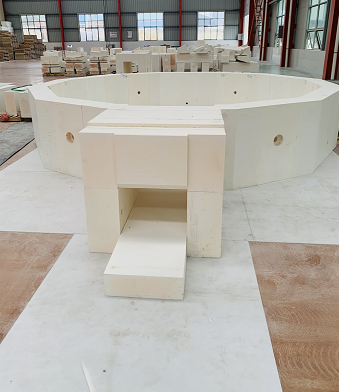Properties and characteristics of AZS refractory bricks
Mar 31, 2022
Fused AZS brick is commonly known as white iron brick, also known as corundum-delineate zircon brick. The main chemical composition is Al2O3 50% to 70%, ZrO2 20% to 40%, and the rest is SiO2. The main mineral composition is baddeleyite zircon (ZrO2), corundum (α-Al2O3), and glass phase. The baddeleyite crystal forms the backbone of the brick body, and the ZrO2 has a high melting point (2715°C), good chemical stability, and strong corrosion resistance to acidic and alkaline media, especially glass liquid.
Fused AZS refractory bricks are used in industrial furnaces such as glass melting furnaces. The parts used in glass melting furnaces are to build the upper pool wall, small furnace flat sill, small furnace stack, tongue sill, and breast wall. Fused AZS refractory bricks should pay attention to the following problems in use:

①Irregular changes in thermal expansion. The expansion curve of fused AZS refractory bricks has an abnormality of around 1000℃. The internal ZrO2 crystal undergoes reversible crystal transformation and has a large volume change. Therefore, bricks containing ZrO2 should not be used at temperatures around 1000℃. Sharply fluctuating parts. When baking the kiln, the temperature change should not be too large at 900 ~ 1150 °C, generally, not more than 15 °C/h, and a stable temperature rise is required. In order to prevent cold wind from blowing in some parts, other bricks should be used to prevent them from bursting.
Zirconium corundum brick
② shrinkage. When pouring and molding, shrinkage cavities often appear at the casting mouth. There are many pores in the brick body and the density is poor. Therefore, when building the glass melting pool wall, the shrinkage cavities are all directed towards the inside of the kiln. If the sprue is facing outwards, when the brick body is eroded to a very thin thickness, it will cause a leakage accident of the molten glass. When used in the upper flame space of the pool kiln, the service life is very long, and the problem of running glass liquid will not occur. Therefore, the casting mouth is used outwards to prolong the service life.
③ eutectic. Fused AZS refractory bricks and clay bricks are in contact with masonry, and the eutectic phenomenon will occur at a high temperature of 1300 °C. Therefore, when selecting refractory materials, it is necessary to avoid contacting two refractory materials with serious eutectic phenomena, such as silica bricks in The underside of the fused zirconium corundum brick is most susceptible to erosion by the fused zirconium corundum brick.
Zirconium corundum brick
Sintered AZS refractory bricks are also known as ceramic bonded aluminosilicate zirconium bricks. Compared with fused AZS refractory bricks, the chemical composition of sintered AZS refractory bricks is similar. However, it has the advantages of no carbon, low glass phase content, uniform structure, no shrinkage crater, good thermal shock stability and corrosion resistance.
Relevant information
-

Main properties of magnesium oxide refractory
Performance characteristics of magnesia refractories and other basic refractories Performance characteristics of magnesia refractories and other basic refractories Refractories containing more than 80% ... -

What properties of lightweight insulation fire clay bricks can be improved by the addition of kyanite?
Lightweight insulation fire clay bricks are a kind of shaped refractory material with clay as the main raw material, which is processed, shaped, dried, and calcined with clay. on the kiln. Due to the r ... -

How is the effect of white fused alumina abrasive used in refractory materials?
After mixing, forming, drying, and firing at high temperature in a shuttle kiln. The product has the characteristics of high refractoriness, good thermal shock stability of white corundum, high high te ... -

Characteristics of refractory magnesia chrome bricks for lime kiln
Lime kilns are mainly classified into square kilns and circular kilns. According to the classification of fired products, they can be divided into lime kilns, ceramic kilns, cement kilns, glass kilns, ...

